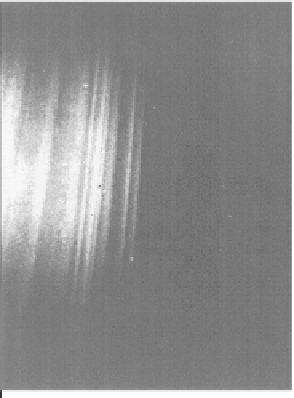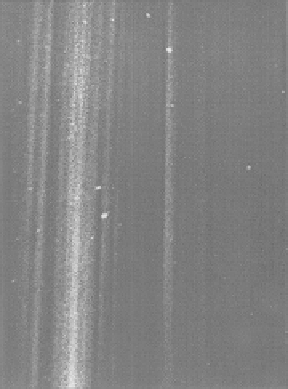Geoscience Reference
In-Depth Information
Above-ground
nuclear test (Kingfish)
Barium release
0
10
20
30
0
10
20
30
Distance (km)
40
50
60
Distance (km)
Figure 6.18
Comparison of a striated barium cloud and a late time nuclear explosion
on the same distance scale. Both events occurred in the 150-200 km height range. [After
Kelley and Livingston (2003). Reproduced with permission of the American Geophysical
Union.]
The effective gravity is then
, which points outward. This condition
is then linearly unstable to the generalized Rayleigh-Taylor instability. After the
nuclear test ban treaty, barium cloud releases fueled further understanding of
the nuclear case as well as CEIS/ESF and led to the computer simulations, which
eventually led to the equatorial simulations presented in Chapter 4.
Whether a cloud is large or small depends on its electrical properties. A small
cloud is required whenever the barium technique is used for tracer experiments,
such as those discussed in relation to Fig. 3.12. The circuit diagram analogy in
Fig. 6.19a applies if we associate
R
2
with the reciprocal of the field line-integrated
Pedersen conductivity in the cloud [
R
2
=
(
Pc
)
−
1
], while
R
1
, is the inverse of the
field line-integrated conductivity in the background ionosphere [
R
1
=
(
Pb
)
−
1
].
if
R
1
ν
in
(
U
−
V
i
)
R
2
, the full ambient potential appears across the cloud and it drifts with
the full velocity
E
B
2
. If the cloud is large (
Pc
>
Pb
), the ambient electric
field is shorted out and the cloud moves more slowly than the background. This
has in fact been observed during a rocket flight, which traversed a dense barium
plasma cloud. The data in Fig. 6.19b show that the electric field was indeed lower
inside the barium cloud than outside (Schutz et al., 1973).
×
B
/













Search WWH ::

Custom Search